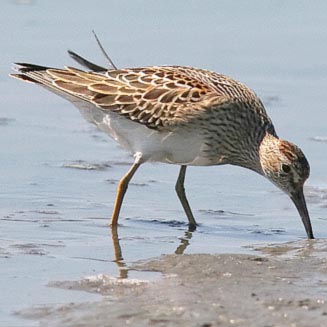|
Calidris melanotos (Pectoral
sandpiper)
Geelpootstrandloper [Afrikaans]; Gestreepte strandloper
[Dutch]; Bécasseau à poitrine cendrée [French]; Graubrust-strandläufer
[German]; Pilrito-peitoral [Portuguese]
Life
> Eukaryotes >
Opisthokonta
> Metazoa (animals) >
Bilateria >
Deuterostomia > Chordata >
Craniata > Vertebrata (vertebrates) > Gnathostomata (jawed
vertebrates) > Teleostomi (teleost fish) > Osteichthyes (bony fish) > Class:
Sarcopterygii (lobe-finned
fish) > Stegocephalia (terrestrial
vertebrates) > Tetrapoda
(four-legged vertebrates) > Reptiliomorpha > Amniota >
Reptilia (reptiles) >
Romeriida > Diapsida > Archosauromorpha > Archosauria >
Dinosauria
(dinosaurs) > Saurischia > Theropoda (bipedal predatory dinosaurs) >
Coelurosauria > Maniraptora > Aves
(birds) >
Order: Charadriiformes > Family: Scolopacidae
 |
|
|
Pectoral sandpiper, California, USA. [photo
Jeff Poklen
©] |
|
Distribution and habitat
Breeds at high latitudes in coastal tundra from Taimyr
Peninsula, Siberia to the western coast of Hudson Bay, Canada. In the
non-breeding season it heads south to South America between 20-40° South, with
smaller numbers in east Asia, Australia and New Zealand. It is a rare vagrant to
southern Africa, with over the three dozen records spread out across the region
(excluding Mozambique), all sighted in the period from September-May. It is most
commonly recorded along the west coast of the Western Cape, generally preferring
freshwater wetlands with fringing grass, sewage works and small farm dams.
References
-
Hockey PAR, Dean WRJ and Ryan PG 2005. Roberts
- Birds of southern Africa, VIIth ed. The Trustees of the John Voelcker
Bird Book Fund, Cape Town.
s |
